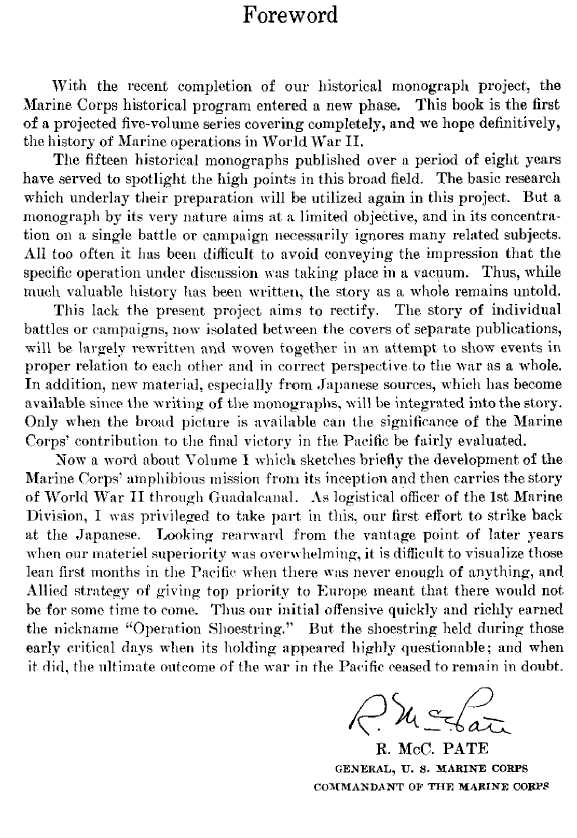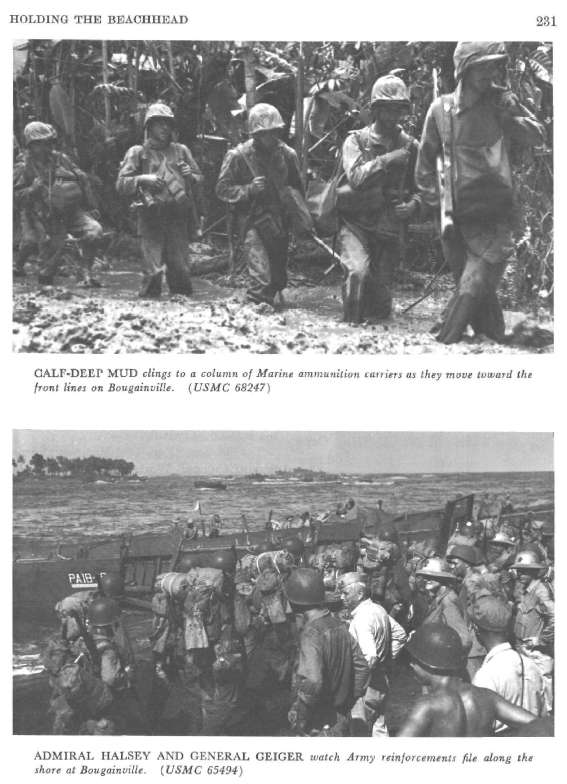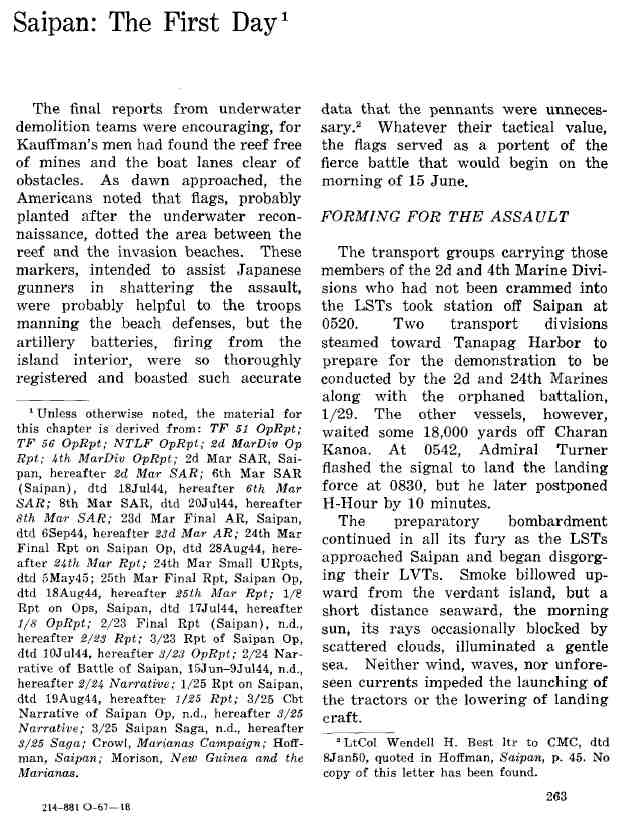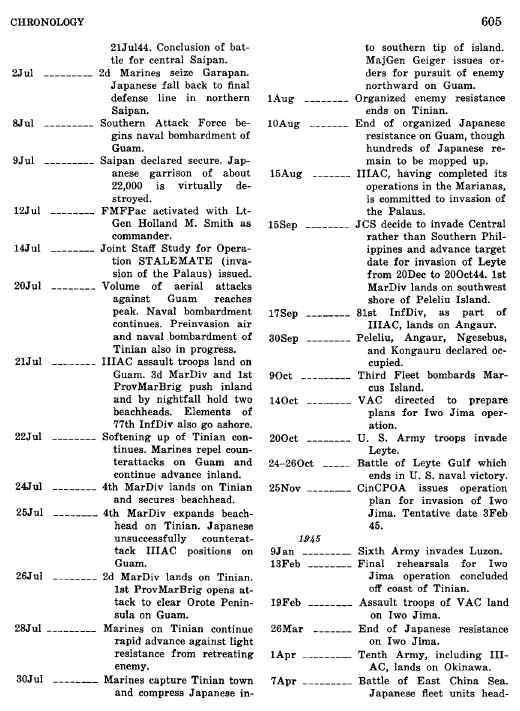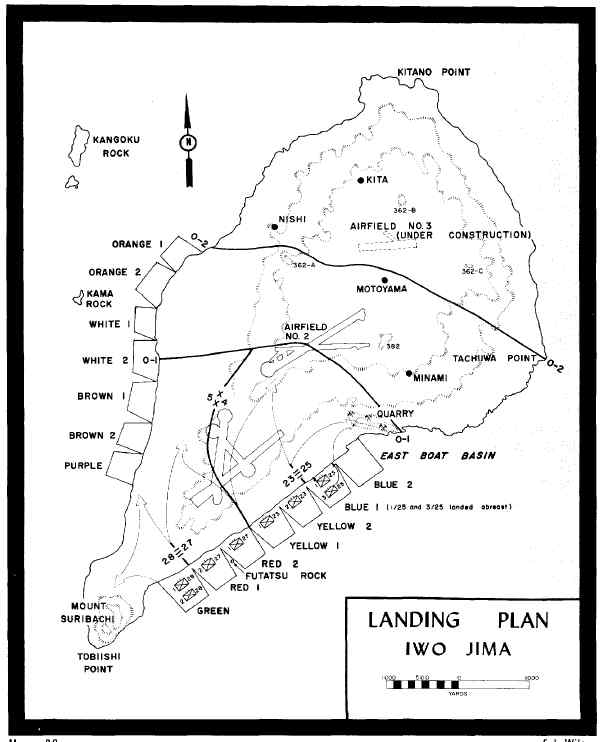|
World War II:
Marine Corps Pacific Operations History Volumes
3,616 pages of history of U.S. Marine Corps Pacific operations in World War II, in five volumes produced by the U.S. Marine Corps, Historical Branch, G-3 Division.
All photos, charts, maps, illustrations and diagrams produced for the volumes are reproduced. The volumes were completed by Marine Corps historians between 1965 and 1972.
The five volumes include:
VOLUME I: PEARL HARBOR TO GUADALCANAL
This volume covers Marine Corps participation through the first precarious year of World War II, when disaster piled on disaster and there seemed no way to check Japanese gains. Advanced bases and garrisons were isolated and destroyed: Guam, Wake, and the Philippines. The attack on Pearl Harbor seriously crippled the U.S. Pacific Fleet. After the fleet was rehabilitated the U.S. Marines launched on Guadalcanal an offensive which was destined to end only on the home islands of the Japanese Empire.
Among the many section headings in this volume are: Evolution of Modern Amphibious Warfare 1920-1941, Marine Occupation of Iceland, The Defense of Wake, Marines in the Philippines, The Siege and Capture of Corregidor, Decision at Midway, Japanese Plans: Toward Midway and the North Pacific, Midway Girds for Battle, and The Turning Point: Guadalcanal.
VOLUME 2: ISOLATION OF RABAUL
The period of World War II covered in this volume was during a time of transition in the fighting when the Allied offensive gradually shifted into high gear, after a grinding start at Guadalcanal. As the situation changed, the make-up of the Fleet Marine Force changed, too. It passed through the era of hit and run and through the time for defensive strategy. Marine raider and parachute battalions were absorbed into regular infantry units, the seacoast batteries of defense battalions became field artillery, and air squadrons were re-equipped with newer and deadlier planes.
Among the many section headings in this volume are: Strategic Situation Spring 1943, TOENAILS Operation, Northern Solomons Operations, The New Britain Campaign, and Marine Air Against Rabaul.
VOLUME 3: CENTRAL PACIFIC DRIVE
This volume covers the series of Central Pacific operations that began at Tarawa in November 1943. It marked a period of steadily increasing momentum in the drive toward the Japanese home islands. To a great extent, these operations were periods of trial and error. During this time Marine Corps amphibious striking force, the Fifth Fleet and the V Amphibious Corps, tested and proved the basic soundness of the doctrine, tactics, and techniques developed by the Navy and Marine Corps in the years before World War II. This was a time of innovation too, when new weapons, improved methods of fire support, and organizational developments all played a large part in U.S. victories. This volume attests that the lessons learned in the Gilberts, were reaffirmed and applied with increasing effectiveness in the Marshalls and Marianas.
Among the many section headings in this volume are .Launching the Central Pacific Offensive, The Gilberts Operation, The Marshalls: Quickening the Pace, Saipan: the Decisive Battle, Assault on Tinian and The Return to Guam.
VOLUME 4 WESTERN PACIFIC OPERATIONS
The period of World War II covered in this volume, essentially from mid-September 1944 to late March 1945, covers the continuation of the United States drive from the Central Pacific to the Western Carolines and the Volcano-Benin Islands at the very doorstep of Japan. This volume details the task of the Marine Corps to put into practice the amphibious doctrine that had been developed during the prewar years, modified and improved during earlier operations in the Solomons, Gilberts, Marshalls, and Marianas. The volume contends that the course of events on Peleliu and Iwo Jima demonstrated the basic soundness of Marine Corps tactics and techniques in the face of skillful and tenacious resistance offered by a highly motivated and well trained opponent who was determined to defend his possessions to the last.
During this time Marine aviation took a stronger role. Frequently denied the opportunity of flying direct support in amphibious operations, Marine aviators developed and put into practice a doctrine of close air support that was key to the recapture of the Philippines. During this tine, in a series of boldly conceived and executed operations, American forces in the Pacific Theater captured and developed a number of strategically placed islands that were to serve as springboards for the inexorable advance towards the Japanese home islands.
By the time the Peleliu operation was launched in mid-September 1944, the Japanese had changed their tactics of defending the beaches and launching a final banzai once the inevitable end was in sight, to a far more sophisticated defense that amounted to an extended delaying action conducted from well dug tunnels and cave positions, which had to be taken at great cost to the attacking force. The battle for Iwo Jima, which got under way on 19 February 1945, represented a battle of attrition in the truest sense, with losses in men and materiel far out of proportion to the size of the objective. Aside from its tactical value, Iwo Jima assumed strategic importance in signaling the Japanese government and people that the United States was determined to win the war in the Pacific, even at the cost of heavy losses.
Among the many section headings in this volume are
The Palaus: Gateway to the Philippines, D-Day on Peleliu, The Leyte Landings, The Luzon Campaign, Southern Philippines Operations, Marine Aviation in the Marianas, Carolines, and at Iwo Jima, Iwo Jima, D-Day on Iwo Jima, The Struggle for Suribachi, and 3rd Marine Division Operations on Iwo Jima.
VOLUME 5: VICTORY AND OCCUPATION
This volume covers Marine Corps activities in the Okinawa invasion and the occupations of Japan and North China as well as the little-known story of Marine prisoners of war. The book relates the Marine Corps' postwar demobilization and reorganization programs as well. By 1945, amphibious warfare doctrine and techniques had become highly developed.
Among the many section headings in this volume are: Okinawa, Project ICEBERG, Occupation of Japan, Last Months in Japan and Marine POW's.
Each volume contains its own index. As a finding aid for this title, all convertible text in the pages have been transcribed and embedded as text. All text capable of being converted can be searched. A searchable cross auto-index is also included for searching of all convertible material. |
